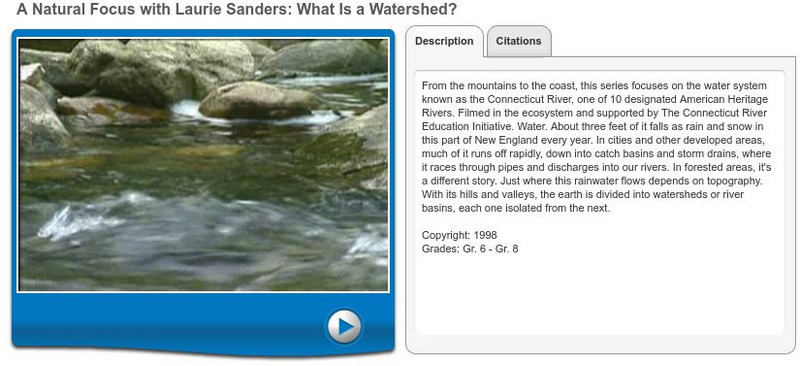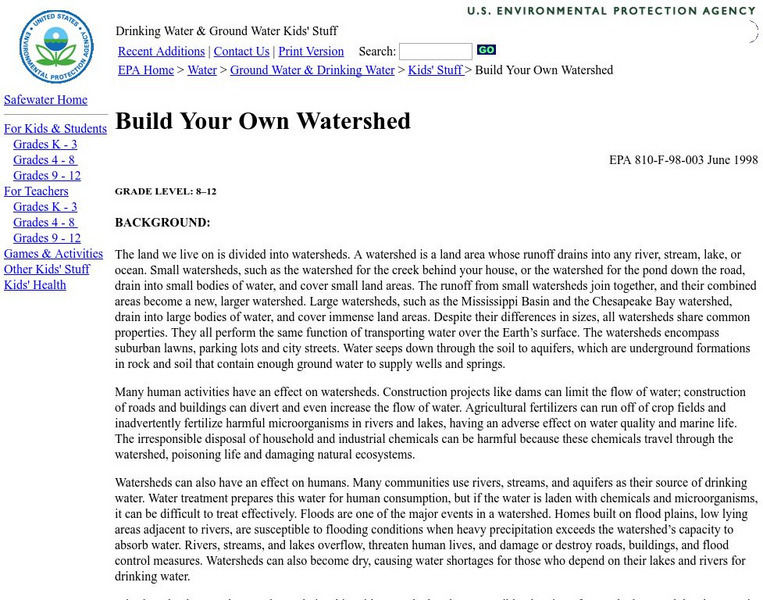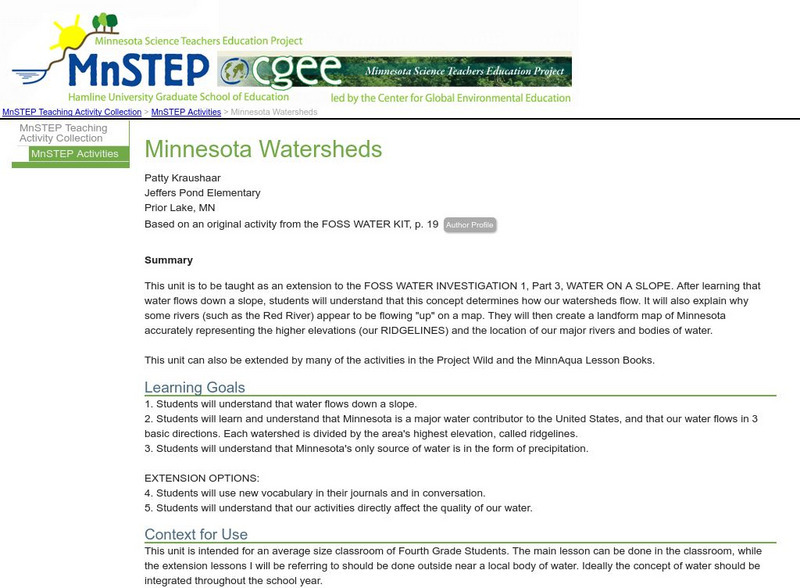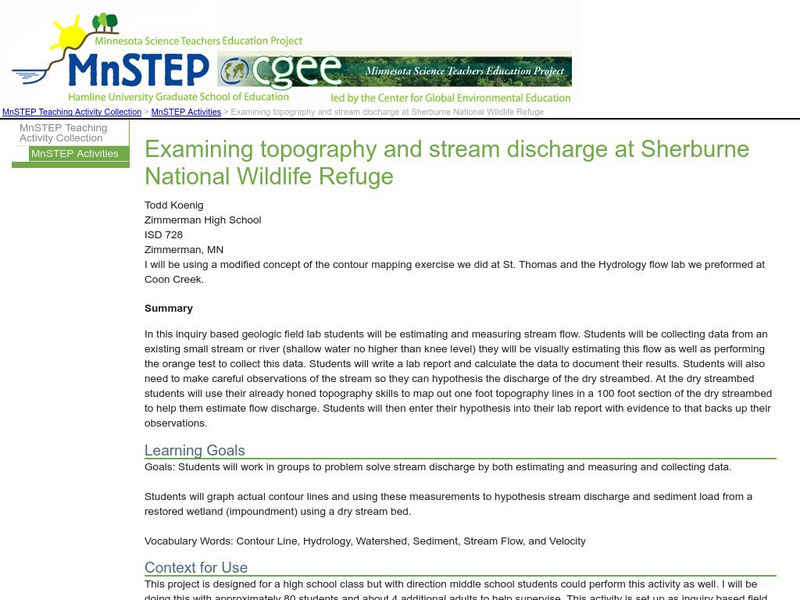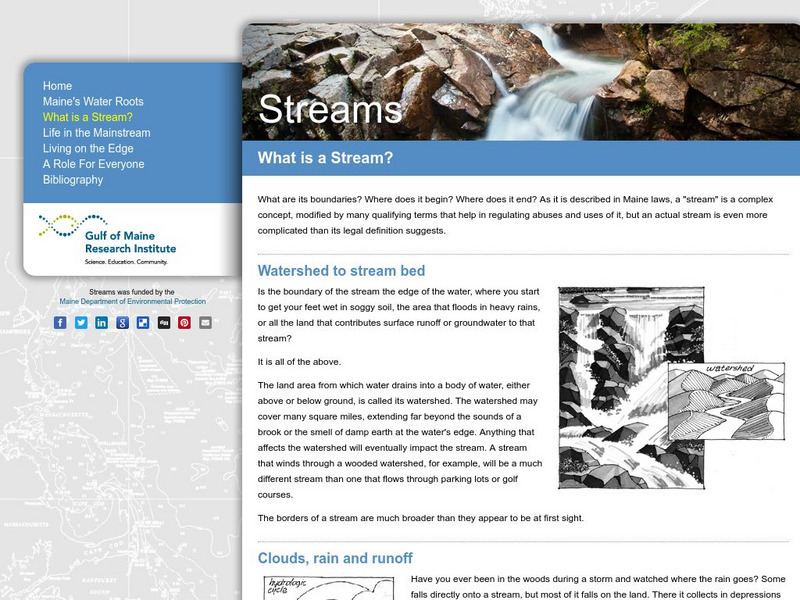University of Wisconsin
University of Wisconsin: Give Water a Hand
National watershed education program engaging young people in environmental service projects. Download their free Action Guide and Leader Guidebook to get your class started on a community service project to help the environment. Action...
Discovery Education
Discovery Education: Homework Helper: What Is a Watershed?
This video describes what watersheds are and where they are located. View several different watersheds and learn how their flow is affected by the topography around them. [7:11]
Other
Marshall University: 1937 Flood: Huntington, West Virginia
Photo collection of 1937 flood in Huntington, West Virginia.
PBS
Pbs: Life at the River's Edge
Discussion of the 100 year flood level and potential for reoccurance.
PBS
Pbs: What's Good About a Flood?
PBS discusses how floods can be beneficial to farmers as it helps increase the harvest.
National Geographic
National Geographic: Visualizing Watershed Health
Using data visualizations that show dissolved oxygen levels, learners analyze the health of the Chesapeake Bay watershed. They will also learn about dead zones, which are aquatic areas where there is insufficient oxygen to support life....
National Geographic
National Geographic: Mapping u.s. Watersheds
Students will identify and explore major rivers and watersheds in the United States.
Utah Education Network
Uen: If Bugs Could Talk Bugs Don't Bug Me
Evaluate the quality of a "water sample" and form a hypothesis about the land use near the location their "water sample" was collected.
PBS
Pbs Learning Media: Ways of Watersheds
Learn about the four phases of the water cycle, the ways in which watersheds are crucial to healthy water, and the best ways to manage local watersheds with this interactive lesson.
BSCS Science Learning
Bscs: Asking and Answering Questions With Data
This inquiry is intended to provide young scholars with practice developing investigable questions that need data, and specifically large datasets, to be answered. Click the teacher resources link for teaching guides and student handouts.
Other
Bscs: Asking and Answering Questions With Data
In this self-directed lesson, students use graphs and maps of water quality to investigate relationships between variables to answer questions. A handout with everything the student needs to complete this lesson is available as a PDF or...
Smithsonian Institution
Smithsonian Environmental Research Center: It's All in the Watershed
Learn about your ecological home on this site. The nation shares the Chesapeake Bay watershed, our ecological home. Most stories on this site focus on separate plants and animals, but together, these stories literally show a web of life.
US Environmental Protection Agency
Epa: Wetlands Protection
This resource provides information regarding what private citizens can do to slow the rate of wetland loss and to improve the quality of our remaining wetlands.
US Environmental Protection Agency
Epa: Build Your Own Watershed
How can you learn to build your own watershed? This site features an activity to illustrate the basic properties of a watershed. Don't miss out.
Next.cc
Next: Watershed
Investigate what a watershed is by engaging in the activities provided. Includes links to explore related sites pertaining to watersheds.
Science Education Resource Center at Carleton College
Serc: Minnesota Watersheds
For this lesson, students will understand that water flows down a slope and determines how watersheds flow. They will also learn that water flows in three basic directions and that each watershed is divided by the area's higher...
Science Education Resource Center at Carleton College
Serc: Investigating How Terrain and Watersheds Are Connected
In this lab, students will investigate the topography of a watershed and determine how it may affect physical stream parameters focusing on how terrain and water systems are connected.
Science Education Resource Center at Carleton College
Serc: Examining Topography Stream Discharge Sherburne National Wildlife Refuge
Learners problem solve stream discharge by estimating, measuring, and collecting data. Students graph actual contour lines, and use these measurements to hypothesize stream discharge and sediment load from a restored wetland using a dry...
Science Education Resource Center at Carleton College
Serc: Water Sheds and Water Quality
Included here is a collection of activities to teach students about watersheds and pollution.
Climate Literacy
Clean: Colorado River Supply
Students examine available data of water in the Colorado River Basin, study the possible consequences of changes to various user groups, and suggest solutions to adapt to these changes.
Other
Alberta Riparian Habitat Management Society: Growing Restoration [Pdf]
This article describes how to go about restoring a freshwater shoreline in a riparian area in Alberta.
Other
Alberta Riparian Habitat Mgt Society: Biodiversity and Riparian Areas [Pdf]
Healthy riparian areas have much higher levels of biodiversity than other types of ecosystems, as explained in this fact sheet. Unfortunately, this also attracts more people, which can contribute to degradation of the ecosystem if the...
Gulf of Maine Research Institute
What Is a Stream?
Discusses how watersheds turn into a stream bed and where the water comes from. Follow the link "Life In the Mainstream" to get more detailed information about streams.
Other
Cwec: Down the Hill . . . Your Watershed (Mini Unit) [Pdf]
Everyone is part of a local watershed and their actions affect the water resources in their watershed. For this mini-unit, young scholars learn about watersheds, why they are important, dangers they face and how watersheds can be protected.

